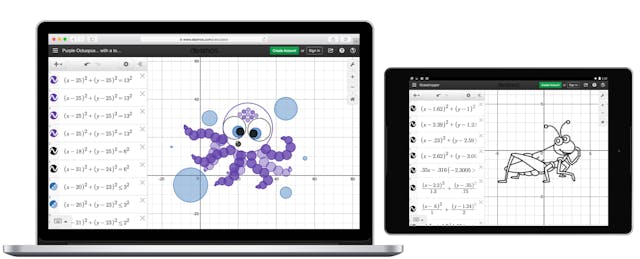If Eli Luberoff had his way, no student would need to buy handheld graphing calculators. For nearly a decade, the founder and CEO of Desmos has been building a free alternative that works on web browsers and mobile devices. Millions of students use it every month, he says.
But the rules in schools have been slow to catch up. Many high-stakes math exams still only allow handheld graphing calculators in the classroom. It’s a reasonable restriction to prevent students from cheating by searching online for solutions.
Yet some test-makers are taking notice and, more importantly, action. The Smarter Balanced Assessment Consortium (SBAC), which administers standardized tests for 15 U.S. states, one territory, and the Bureau of Indian Education, has agreed to make the Desmos calculator available as a tool in its online exams.
Smarter Balanced contracts with the American Institute of Research to develop and deliver the online tests via a secure web browser. The browser is “locked,” thus limiting access to only pre-approved sites. Under this partnership with Desmos, students who are taking the test can use the San Francisco company’s calculator from a list of built-in support tools.
Making Desmos’ tools available for free to students and teachers has always been core to the company’s mission, Luberoff says. That means the revenue from its partnership with Smarter Balanced is important for helping Desmos survive. Other paying organizations include the College Board, which uses Desmos in its SpringBoard math program, and Pearson, which embeds the tool in its high school and college preparatory math offerings. Such deals are “how we pay the bills,” Luberoff says.
For Luberoff, this deal is much bigger than the dollars. He sees it as another step in his battle against the “destructive and inequitable monopoly that TI [Texas Instruments] makes hundreds of millions of dollars from,” he tells EdSurge. A report from Washington Post found that Texas Instruments and Casio have essentially cornered the graphing calculator market.
For schools that already provide computers for online assessments, Luberoff contends it’s unreasonable to require students—particularly those from low-income communities—to fork out $100 to buy a graphing calculator just to take a math test. And as assessments increasingly move online, tools that perform basic functions should not require additional purchases, he argues.
As devices proliferate in the classrooms—whether brought by students or supplied by schools—some math teachers have become more amenable to letting pupils use online calculators. “For me, it’s becoming tougher and tougher to tell kids to buy a graphing calculator,” says Bob Lochel, a math teacher at Hatboro-Horsham High School in Pennsylvania. “Frankly, nearly everything you want to do on a graphing calculator, you can do on your cell phone.”
Peter Macintosh, a math teacher at Unity High School in Oakland, Calif., says “we tell our kids to play with Desmos all the time and check their work…they don’t need to be using TI graphing calculators for Algebra I and II.” Yet he’s not given up on the handhelds yet. He does require the devices for his calculus course—partly because they are on the list of approved calculators for the AP exams.
Desmos has already made headway in getting approval from some schools to be used for testing. Two years ago it notched a deal with Eanes Independent School District (in Austin, Texas) to permit students to use the Desmos iPad app when they took eighth-grade STAAR test. “We’ve learned a lot from working with these partners,” offers Luberoff. Depending on the test, his team has had to disable certain features that could have helped students solve questions immediately.
Even Smarter Balanced stands to benefit from the partnership. The deal with Desmos gives its maligned exams a much-needed technology upgrade. The first versions of the test, released in 2015, woefully underwhelmed: Odd glitches aside, the awkwardly designed user interfaces and poorly phrased questions befuddled math educators and technologists. Steve Rasmussen, a former math teacher and curriculum developer, called the test “fatally flawed.”
Rasmussen says the Desmos partnership is a step in the right direction. “SBAC has made a good choice in electing to add the Desmos graphing calculator to its mathematics testing environment,” he tells EdSurge via email.
Still, he added, “SBAC has a lot more work to do if they want to deliver a usable and accurate measure of student mathematical competencies.” The organization “must remove the old mathematical technologies from the heart of their testing engine and thoroughly vet the entire database of mathematics questions for accuracy and clarity.”


